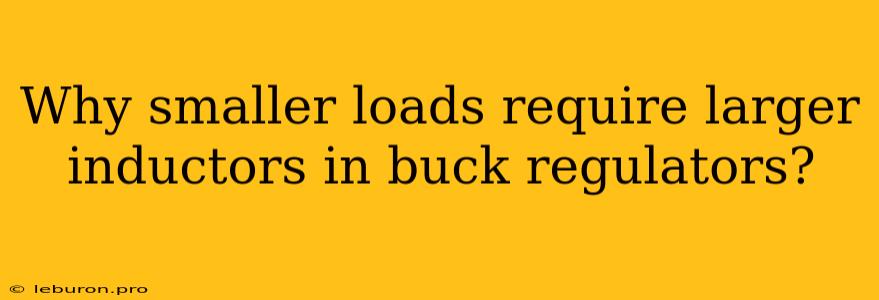Buck regulators are a fundamental component in power electronics, playing a vital role in converting higher voltage DC input to a lower voltage DC output. Their efficiency and versatility make them ubiquitous in various applications, from mobile devices to industrial equipment. One key aspect of buck regulator design, often overlooked by beginners, is the impact of load current on the choice of inductor. While it might seem counterintuitive, smaller loads require larger inductors in buck regulators. This article delves into the reasons behind this relationship, explaining the underlying principles and providing insights into optimal inductor selection.
The Role of Inductors in Buck Regulators
Before exploring the connection between load current and inductor size, it's essential to understand the role of inductors in buck regulators. At their core, buck regulators utilize the principle of energy storage and release. The inductor serves as the energy storage element, accumulating energy from the input voltage during the 'on' state of the switching element (typically a MOSFET). During the 'off' state, the inductor releases this stored energy to the load, maintaining a relatively constant output voltage.
Inductance and Energy Storage
The inductance (L) of the inductor directly influences its ability to store energy. A higher inductance value allows the inductor to store more energy at a given current. This energy is proportional to the square of the current flowing through the inductor (E = 1/2 * L * I²). Consequently, larger inductors are capable of storing more energy.
Inductors and Current Ripple
Another critical factor in buck regulator design is current ripple. Current ripple refers to the fluctuations in the inductor current during its charging and discharging cycles. A smaller inductor results in a larger current ripple, while a larger inductor reduces the ripple. This ripple directly impacts the output voltage stability and the performance of the buck regulator.
Why Smaller Loads Require Larger Inductors
The relationship between load current and inductor size might seem counterintuitive at first. We know that larger inductors store more energy, but why are they necessary for smaller loads? The answer lies in the interplay between load current, inductor current ripple, and the desired output voltage stability.
Maintaining Output Voltage Stability
The key to understanding this relationship is the output voltage ripple. A stable output voltage is crucial for proper operation of the load. Higher load currents result in a smaller current ripple for a given inductor due to the higher average current flowing through the inductor. This smaller ripple helps maintain a more stable output voltage.
However, with smaller loads, the average current is lower. This lower average current exacerbates the effect of current ripple on the output voltage, leading to larger voltage fluctuations. To compensate for this, a larger inductor is required to minimize the current ripple and ensure stable output voltage.
Example Scenario:
Consider two scenarios:
- Scenario 1: High Load Current (e.g., 1A) - A smaller inductor can be used as the current ripple will be relatively small, resulting in a stable output voltage.
- Scenario 2: Low Load Current (e.g., 10mA) - With a smaller inductor, the current ripple would be significantly higher, leading to large voltage fluctuations. To maintain stable output voltage, a larger inductor is needed to reduce the ripple.
Consequences of Using the Wrong Inductor Size
Choosing an inappropriately sized inductor for the load current can have detrimental effects on the buck regulator's performance:
- Excessive Output Voltage Ripple: An insufficiently large inductor will lead to high current ripple, resulting in significant output voltage fluctuations. This can cause malfunction in sensitive loads or trigger undesirable behavior in certain applications.
- Reduced Efficiency: High current ripple leads to increased losses in the inductor and switching element. These losses translate to lower efficiency in the buck regulator, leading to wasted power.
- Increased Stress on Components: Large current ripple can stress the switching element, the inductor itself, and other components in the circuit. This can shorten their lifespan and increase the risk of premature failure.
Conclusion
The choice of inductor size in a buck regulator is crucial for optimal performance. While a larger inductor generally means more energy storage, it is essential for smaller loads to minimize current ripple and maintain stable output voltage. Failure to select the appropriate inductor size can lead to excessive output voltage ripple, decreased efficiency, and increased stress on components. Understanding the relationship between load current, inductor size, and current ripple allows for informed design decisions and ensures efficient and reliable operation of buck regulators in various applications.
